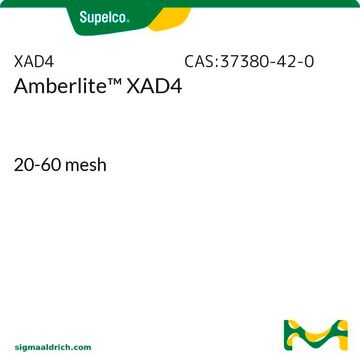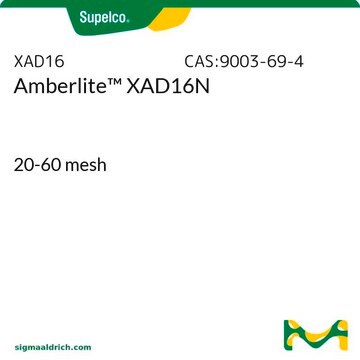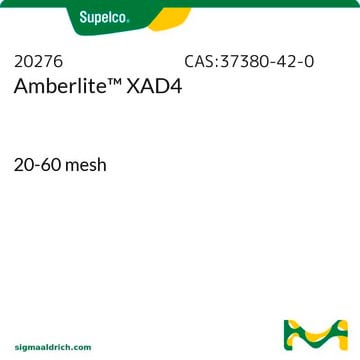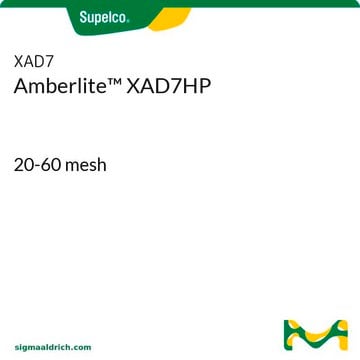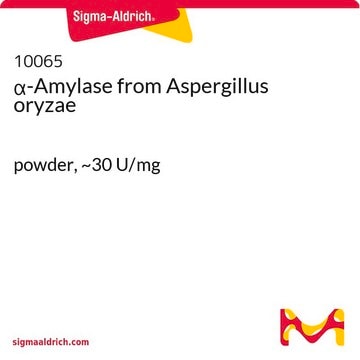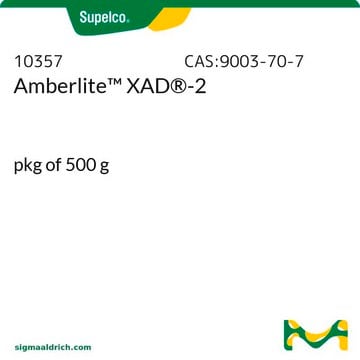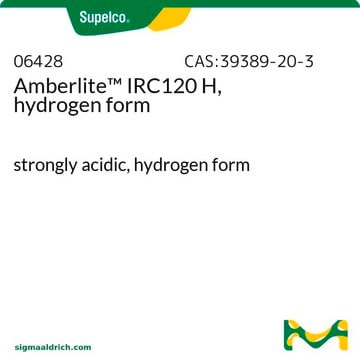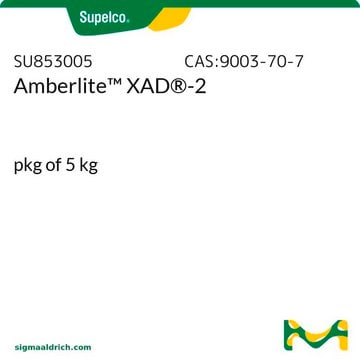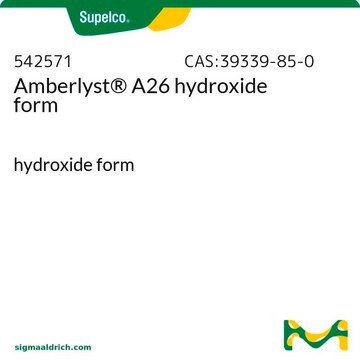Recommended Products
form
solid
autoignition temp.
800 °F
packaging
pkg of 500 g
technique(s)
HPLC: suitable
LPLC: suitable
surface area
750 m2/g
matrix
styrene-divinylbenzene
matrix active group
polymer
particle size
20-60 mesh
pore size
~0.98 mL/g pore volume
100 Å mean pore size
density
1.02 g/mL (true wet)(lit.)
1.08 g/mL (skeletal)(lit.)
separation technique
reversed phase
Looking for similar products? Visit Product Comparison Guide
Related Categories
General description
Amberlite XAD4, a nonpolar absorbent, used for stripping and concentration of organic compounds. It is also used in developing chelating ligands due to its properties like, porosity, high surface area, purity and durability.
Nonionic macroreticular resin that adsorbs and releases ionic species through hydrophobic and polar interactions; usually used under isocratic conditions.
Application
Amberlite™ XAD4 was used:
- in rapid fractionation technique
- as sorbent for HPLC analysis
Polyaromatic adsorbent for small hydrophobic compounds, surfactants, pharmaceutical manufacturing, phenols, chlorinated organics, pesticide removal and recovery, and organic removal from aqueous food streams.
Other Notes
Two particle sizes are available:
Mesh 20-60 are Cat. Nos. 20276, 10358, XAD4
Mesh 20-50 is Cat. No. 06444
Mesh 20-60 are Cat. Nos. 20276, 10358, XAD4
Mesh 20-50 is Cat. No. 06444
Legal Information
Amberlite is a trademark of DuPont de Nemours, Inc.
Storage Class Code
11 - Combustible Solids
WGK
WGK 3
Flash Point(F)
Not applicable
Flash Point(C)
Not applicable
Personal Protective Equipment
dust mask type N95 (US), Eyeshields, Gloves
Choose from one of the most recent versions:
Already Own This Product?
Find documentation for the products that you have recently purchased in the Document Library.
Customers Also Viewed
Characterization and applications of Amberlite XAD-4 in preparative liquid chromatography
Pietrzyk, D. J., and J. D. Stodola
Analytical Chemistry, 53, 1822-1828 (1981)
Antoine P Trzcinski et al.
Journal of environmental science and health. Part A, Toxic/hazardous substances & environmental engineering, 46(13), 1539-1548 (2011-10-14)
In this study, various methods were compared to reduce the Chemical Oxygen Demand (COD) content of stabilised leachate from a Submerged Anaerobic Membrane Bioreactor (SAMBR). It was found that Powdered Activated Carbon (PAC) resulted in greater COD removals (84 %)
Chao Huang et al.
New biotechnology, 29(3), 372-378 (2011-04-05)
Oleaginous yeast Trichosporon fermentans was proved to be able to use sulphuric acid-treated sugar cane bagasse hydrolysate as substrate to grow and accumulate lipid. Activated charcoal was shown as effective as the more expensive resin Amberlite XAD-4 for removing the
Passively capturing air data on more volatile chemicals.
Kellyn Betts
Environmental science & technology, 43(4), 978-978 (2009-03-27)
Corjan van den Berg et al.
Biotechnology and bioengineering, 100(3), 466-472 (2008-04-29)
The sustainable production of fine/bulk chemicals is often hampered by product toxicity and inhibition to the producing micro-organisms. Consequently, the product must be removed from the micro-organisms' environment. To achieve this, so-called solvent-impregnated resins (SIRs) as well as commercial resins
Our team of scientists has experience in all areas of research including Life Science, Material Science, Chemical Synthesis, Chromatography, Analytical and many others.
Contact Technical Service